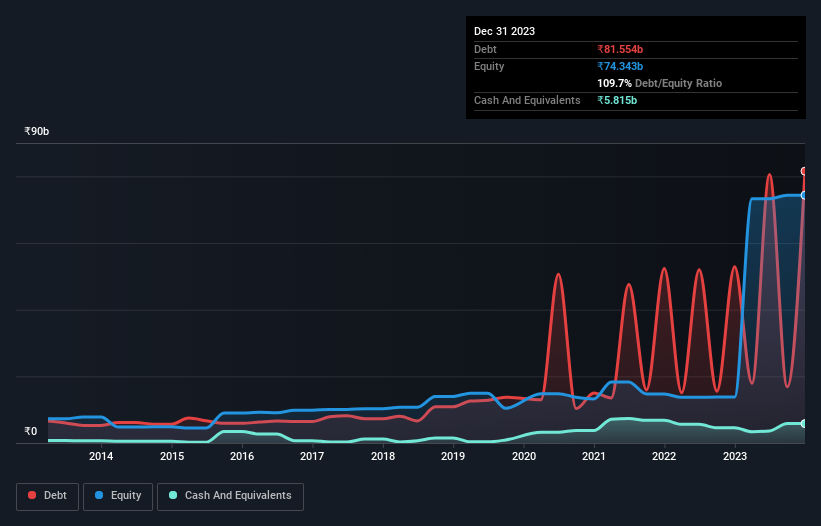Howard Marks put it nicely when he said that, rather than worrying about share price volatility, 'The possibility of permanent loss is the risk I worry about... and every practical investor I know worries about.' So it seems the smart money knows that debt - which is usually involved in bankruptcies - is a very important factor, when you assess how risky a company is. As with many other companies PVR INOX Limited (NSE:PVRINOX) makes use of debt. But the real question is whether this debt is making the company risky.
What Risk Does Debt Bring?
Generally speaking, debt only becomes a real problem when a company can't easily pay it off, either by raising capital or with its own cash flow. In the worst case scenario, a company can go bankrupt if it cannot pay its creditors. While that is not too common, we often do see indebted companies permanently diluting shareholders because lenders force them to raise capital at a distressed price. Of course, plenty of companies use debt to fund growth, without any negative consequences. When we examine debt levels, we first consider both cash and debt levels, together.
See our latest analysis for PVR INOX
What Is PVR INOX's Net Debt?
The image below, which you can click on for greater detail, shows that at September 2023 PVR INOX had debt of ₹81.6b, up from ₹52.9b in one year. However, it does have ₹5.82b in cash offsetting this, leading to net debt of about ₹75.7b.

How Healthy Is PVR INOX's Balance Sheet?
Zooming in on the latest balance sheet data, we can see that PVR INOX had liabilities of ₹23.4b due within 12 months and liabilities of ₹72.4b due beyond that. Offsetting this, it had ₹5.82b in cash and ₹2.52b in receivables that were due within 12 months. So it has liabilities totalling ₹87.4b more than its cash and near-term receivables, combined.
This deficit is considerable relative to its market capitalization of ₹135.2b, so it does suggest shareholders should keep an eye on PVR INOX's use of debt. This suggests shareholders would be heavily diluted if the company needed to shore up its balance sheet in a hurry.
In order to size up a company's debt relative to its earnings, we calculate its net debt divided by its earnings before interest, tax, depreciation, and amortization (EBITDA) and its earnings before interest and tax (EBIT) divided by its interest expense (its interest cover). This way, we consider both the absolute quantum of the debt, as well as the interest rates paid on it.
PVR INOX shareholders face the double whammy of a high net debt to EBITDA ratio (8.4), and fairly weak interest coverage, since EBIT is just 0.83 times the interest expense. This means we'd consider it to have a heavy debt load. The silver lining is that PVR INOX grew its EBIT by 113% last year, which nourishing like the idealism of youth. If it can keep walking that path it will be in a position to shed its debt with relative ease. The balance sheet is clearly the area to focus on when you are analysing debt. But it is future earnings, more than anything, that will determine PVR INOX's ability to maintain a healthy balance sheet going forward. So if you want to see what the professionals think, you might find this free report on analyst profit forecasts to be interesting.
Finally, a business needs free cash flow to pay off debt; accounting profits just don't cut it. So it's worth checking how much of that EBIT is backed by free cash flow. Over the last two years, PVR INOX actually produced more free cash flow than EBIT. That sort of strong cash generation warms our hearts like a puppy in a bumblebee suit.
Our View
PVR INOX's interest cover was a real negative on this analysis, as was its net debt to EBITDA. But its conversion of EBIT to free cash flow was significantly redeeming. Looking at all this data makes us feel a little cautious about PVR INOX's debt levels. While debt does have its upside in higher potential returns, we think shareholders should definitely consider how debt levels might make the stock more risky. Of course, we wouldn't say no to the extra confidence that we'd gain if we knew that PVR INOX insiders have been buying shares: if you're on the same wavelength, you can find out if insiders are buying by clicking this link.
Of course, if you're the type of investor who prefers buying stocks without the burden of debt, then don't hesitate to discover our exclusive list of net cash growth stocks, today.
New: Manage All Your Stock Portfolios in One Place
We've created the ultimate portfolio companion for stock investors, and it's free.
• Connect an unlimited number of Portfolios and see your total in one currency
• Be alerted to new Warning Signs or Risks via email or mobile
• Track the Fair Value of your stocks
Have feedback on this article? Concerned about the content? Get in touch with us directly. Alternatively, email editorial-team (at) simplywallst.com.
This article by Simply Wall St is general in nature. We provide commentary based on historical data and analyst forecasts only using an unbiased methodology and our articles are not intended to be financial advice. It does not constitute a recommendation to buy or sell any stock, and does not take account of your objectives, or your financial situation. We aim to bring you long-term focused analysis driven by fundamental data. Note that our analysis may not factor in the latest price-sensitive company announcements or qualitative material. Simply Wall St has no position in any stocks mentioned.
About NSEI:PVRINOX
PVR INOX
A theatrical exhibition company, engages in the exhibition, distribution, and production of movies in India and Sri Lanka.
Adequate balance sheet and fair value.
Market Insights
Community Narratives



